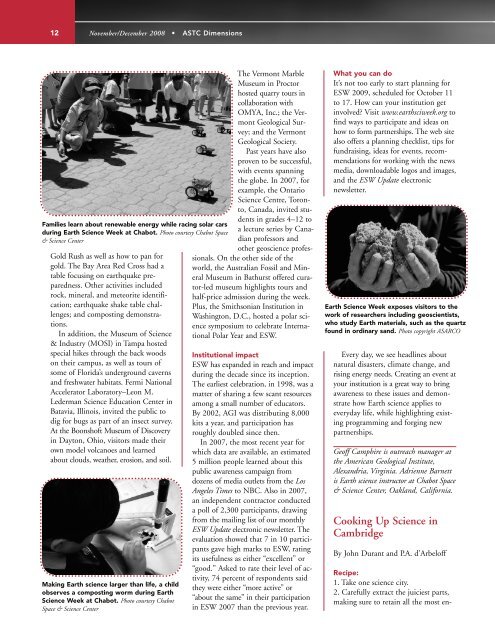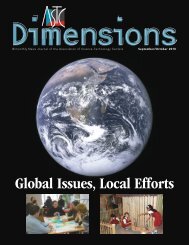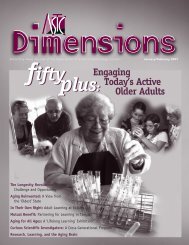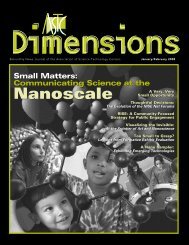Download - Association of Science - Technology Centers
Download - Association of Science - Technology Centers
Download - Association of Science - Technology Centers
You also want an ePaper? Increase the reach of your titles
YUMPU automatically turns print PDFs into web optimized ePapers that Google loves.
12 November/December 2008 • ASTC Dimensions<br />
Families learn about renewable energy while racing solar cars<br />
during Earth <strong>Science</strong> Week at Chabot. Photo courtesy Chabot Space<br />
& <strong>Science</strong> Center<br />
Gold Rush as well as how to pan for<br />
gold. The Bay Area Red Cross had a<br />
table focusing on earthquake preparedness.<br />
Other activities included<br />
rock, mineral, and meteorite identification;<br />
earthquake shake table challenges;<br />
and composting demonstrations.<br />
In addition, the Museum <strong>of</strong> <strong>Science</strong><br />
& Industry (MOSI) in Tampa hosted<br />
special hikes through the back woods<br />
on their campus, as well as tours <strong>of</strong><br />
some <strong>of</strong> Florida’s underground caverns<br />
and freshwater habitats. Fermi National<br />
Accelerator Laboratory–Leon M.<br />
Lederman <strong>Science</strong> Education Center in<br />
Batavia, Illinois, invited the public to<br />
dig for bugs as part <strong>of</strong> an insect survey.<br />
At the Boonsh<strong>of</strong>t Museum <strong>of</strong> Discovery<br />
in Dayton, Ohio, visitors made their<br />
own model volcanoes and learned<br />
about clouds, weather, erosion, and soil.<br />
Making Earth science larger than life, a child<br />
observes a composting worm during Earth<br />
<strong>Science</strong> Week at Chabot. Photo courtesy Chabot<br />
Space & <strong>Science</strong> Center<br />
The Vermont Marble<br />
Museum in Proctor<br />
hosted quarry tours in<br />
collaboration with<br />
OMYA, Inc.; the Vermont<br />
Geological Survey;<br />
and the Vermont<br />
Geological Society.<br />
Past years have also<br />
proven to be successful,<br />
with events spanning<br />
the globe. In 2007, for<br />
example, the Ontario<br />
<strong>Science</strong> Centre, Toronto,<br />
Canada, invited students<br />
in grades 4–12 to<br />
a lecture series by Canadian<br />
pr<strong>of</strong>essors and<br />
other geoscience pr<strong>of</strong>essionals.<br />
On the other side <strong>of</strong> the<br />
world, the Australian Fossil and Mineral<br />
Museum in Bathurst <strong>of</strong>fered curator-led<br />
museum highlights tours and<br />
half-price admission during the week.<br />
Plus, the Smithsonian Institution in<br />
Washington, D.C., hosted a polar science<br />
symposium to celebrate International<br />
Polar Year and ESW.<br />
Institutional impact<br />
ESW has expanded in reach and impact<br />
during the decade since its inception.<br />
The earliest celebration, in 1998, was a<br />
matter <strong>of</strong> sharing a few scant resources<br />
among a small number <strong>of</strong> educators.<br />
By 2002, AGI was distributing 8,000<br />
kits a year, and participation has<br />
roughly doubled since then.<br />
In 2007, the most recent year for<br />
which data are available, an estimated<br />
5 million people learned about this<br />
public awareness campaign from<br />
dozens <strong>of</strong> media outlets from the Los<br />
Angeles Times to NBC. Also in 2007,<br />
an independent contractor conducted<br />
a poll <strong>of</strong> 2,300 participants, drawing<br />
from the mailing list <strong>of</strong> our monthly<br />
ESW Update electronic newsletter. The<br />
evaluation showed that 7 in 10 participants<br />
gave high marks to ESW, rating<br />
its usefulness as either “excellent” or<br />
“good.” Asked to rate their level <strong>of</strong> activity,<br />
74 percent <strong>of</strong> respondents said<br />
they were either “more active” or<br />
“about the same” in their participation<br />
in ESW 2007 than the previous year.<br />
What you can do<br />
It’s not too early to start planning for<br />
ESW 2009, scheduled for October 11<br />
to 17. How can your institution get<br />
involved? Visit www.earthsciweek.org to<br />
find ways to participate and ideas on<br />
how to form partnerships. The web site<br />
also <strong>of</strong>fers a planning checklist, tips for<br />
fundraising, ideas for events, recommendations<br />
for working with the news<br />
media, downloadable logos and images,<br />
and the ESW Update electronic<br />
newsletter.<br />
Earth <strong>Science</strong> Week exposes visitors to the<br />
work <strong>of</strong> researchers including geoscientists,<br />
who study Earth materials, such as the quartz<br />
found in ordinary sand. Photo copyright ASARCO<br />
Every day, we see headlines about<br />
natural disasters, climate change, and<br />
rising energy needs. Creating an event at<br />
your institution is a great way to bring<br />
awareness to these issues and demonstrate<br />
how Earth science applies to<br />
everyday life, while highlighting existing<br />
programming and forging new<br />
partnerships.<br />
Ge<strong>of</strong>f Camphire is outreach manager at<br />
the American Geological Institute,<br />
Alexandria, Virginia. Adrienne Barnett<br />
is Earth science instructor at Chabot Space<br />
& <strong>Science</strong> Center, Oakland, California.<br />
Cooking Up <strong>Science</strong> in<br />
Cambridge<br />
By John Durant and P.A. d’Arbel<strong>of</strong>f<br />
Recipe:<br />
1. Take one science city.<br />
2. Carefully extract the juiciest parts,<br />
making sure to retain all the most en-





